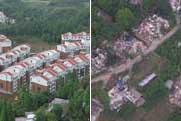China
Planned orbital correction canceled for China´s lunar probe
"It's the first time for BACC to conduct such an international cooperation to control Chang'e-1, which will enhance BACC's preciseness in further controlling the satellite," he said.
After the probe entered the moon's orbit, it would brake several times to slow down so that it can be captured by the lunar gravity and become a real circumlunar satellite.
It would relay the first picture of the moon in late November and would then continue scientific explorations of the moon for a year.
China's first lunar probe, Chang'e-1, named after a legendary Chinese goddess who flew to the moon, blasted off on a Long March 3A carrier rocket on Oct. 24 from the Xichang Satellite Launch Center in southwestern Sichuan Province.
The 2,350-kg satellite carried eight probing facilities, including a stereo camera and interferometer, an imager and gamma/x-ray spectrometer, a laser altimeter, a microwave detector, a high energy solar particle detector and a low energy ion detector.
It will fulfill four scientific objectives, including a three-dimensional survey of the Moon's surface, analysis of the abundance and distribution of elements on lunar surface, an investigation of the characteristics of lunar regolith and the powdery soil layer on the surface, and an exploration of the circumstance between the earth and the moon.
China's lunar orbiter project has cost 1.4 billion yuan (187 million U.S. dollars) since research and development of the project was approved at the beginning of 2004.
The launch of the orbiter marks the first step of China's three-stage moon mission, which will lead to a moon landing and launch of a moon rover at around 2012. In the third phase, another over will land on the moon and return to earth with lunar soil and stone samples for scientific research at around 2017.
China carried out its maiden piloted space flight in October 2003, making it only the third country in the world after the former Soviet Union and the United States to have sent men into space. In October 2005, China completed its second manned space flight, with two astronauts on board.
Editor:Yang Jie



